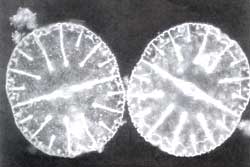Staying Cool
 AFTER years of disbelief, the world has finally realised that global warming, far from being an eccentric theory cooked up by environmentalists, is a very real threat. We are feeling the effects already: the us, for instance, experienced one of the hottest summers in its history this year. And if nations continue to spew greenhouse gases at the current rates, then things can become too hot for comfort.
AFTER years of disbelief, the world has finally realised that global warming, far from being an eccentric theory cooked up by environmentalists, is a very real threat. We are feeling the effects already: the us, for instance, experienced one of the hottest summers in its history this year. And if nations continue to spew greenhouse gases at the current rates, then things can become too hot for comfort.
Scientists all over the planet have been trying to come up with various global cooling plans that might undo the effects of global warming and make everything okay again. But it has been difficult, and almost all of these plans suffer from major drawbacks or are too region-specific to really make a difference. Now, a few us chemical engineers think they have an answer to the problem. Chemical engineers from the Louisiana State University say massive concrete bails could take at least some heat out of global warming. They say the balls will be colonised by algae which "fix" carbon from the atmosphere and trap it in sediment.
Their plan is to dump concrete hemispheres dubbed "reef balls" into estuaries and coastal waters, providing large surface areas for marine algae to colonise. The researchers believe that each of these hemispheres could remove hundreds of kilograms (kg) of carbon from the atmosphere every year.
The Louisiana team aims to attract algae that grow 20 times faster than other free-floating forms. As they grow and photosynthesise, they extract carbon dioxide (CO2) from the surrounding waters, which is replenished by CO2 from the atmosphere.
Carl Knopf, chairperson of chemical engineering at the university, said: "We are trying the idea out in the lab now, using balls 15 centimetres in diameter. But in the next stage, in the ocean, we will be sinking balls three metres across or more."
One challenge has been to make the concrete chemically neutral. Normal concrete is too alkaline for microalgae to colonise. Seawater will eventually neutralise it, but not before organisms with less power to "fix" co: to it under high pressure, have invaded the concrete surface.
Ironically, neutralising the concrete means applying CO2 to it under high pressure, while the concrete is still wet. Treating the concrete with a foaming agent creates a sponge-like surface which has a bigger surface area for the algae to grow on. "A hollow hemi-sphere or reef ball about one metre across could provide about 100 sq m of active surface area for microalgae growth. Each reef hemisphere could remove 200 kg of carbon from the atmosphere annually, and this process would go on indefinitely," says Knopf. The team has calculated lhat to soak up all the CO2 the us produces in a year would require almost a billion-and-a-half reef balls. Still, the team believes, it is a start.
The balls could eventually be used to dispose of CO2, from fossil-fuel power plants. Emissions could be pumped into the ocean close to a concrete reef system, say researchers.
The first test balls could be lowered into the ocean as early as next year. Knopf plans to make the hollow balls buoyant enough to float into place by putting an inflated rubber ball inside them, and to sink them by deflating the ball slowly. Once in place, says team's marine biologist Bob Gambell, the balls will both consume CO2 from the ocean and provide conditions on the sea bed similar to those to a natural reef.
Related Content
- Sustainable food cold chains: opportunities, challenges and the way forward
- As temperatures rise, a billion people struggle to stay cool; India at risk
- On World Environment Day, CSE warns no one is safe from deadly ozone pollution-- including chief minister Arvind Kejriwal
- India State of the Environment Report : The Monthly Overview, September 2013
- NTPC to invest Rs 1-lakh-cr in mega hydro project in Arunachal
- Lizards face extinction from global warming
